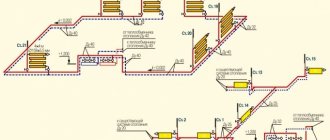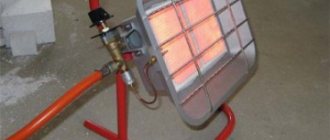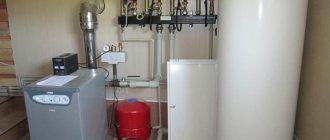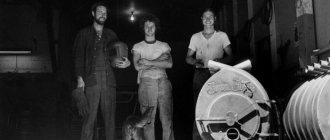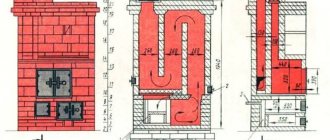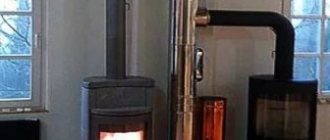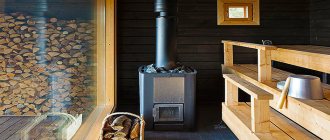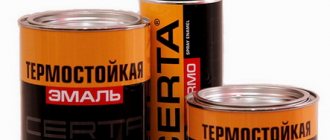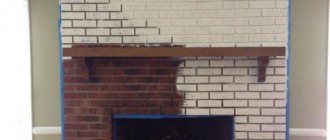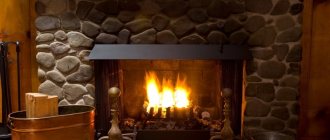Surely, you don’t know what difficulties you may encounter if you decide to use stove heating with a water circuit in a wooden house! There is a “hackneyed” stereotype that it is difficult to heat a house with a stove if you do not run a water circuit throughout the house, but this is not true! The water circuit in the furnace causes a lot of problems both during installation and operation.
In this article I will try to weigh the pros and cons, and it’s up to you to decide... And at the end I will show a short video from a real house under construction, where the furnace-boiler is made with a water circuit. We will talk about wood stoves.
Why do we need a water circuit in a heating system?
It is believed that in a house with stove heating, the corners and floors are always cold. There is also an opinion that in a house with stove heating the windows always “cry”. The whole point is that the heating device - the stove in the house - heats in a fairly localized manner. There is a stove in one place...
So, in order to reduce heat loss near the windows - from the windows. And also in order to distribute the heat from the stove to the edges of the house - to the corners and places where the walls meet the floor - we need a water circuit.
It can be assumed that a water circuit is necessary if there is at least one room in the house where the surface of the stove does not directly open. And if there are 2 or three such rooms, then even more so...
Briefly about how a water circuit is usually made in a house with a stove.
In old houses, in villages without gas, stove heating with a water circuit in a wooden house was solved as follows. a boiler was built into the furnace - right into the firebox. From the stove, by gravity, through a regular open expansion tank (under the ceiling), water was released through wide pipes. This could be done either in a circular pattern around the house. Most often they did it closed - supply and return along one wall.
Modern building materials make it possible to make wiring with the transition to plastic. The wiring is already done on aluminum radiators under the windows. This allows you to significantly reduce the need for heating; the coolant releases heat “in doses” through radiators, which can also be adjusted.
In this way, you can try to solve one of the main problems of stove heating with a water circuit in a wooden house - the rapid cooling of the coolant. Still, plastic has lower thermal conductivity than steel. Moreover, a plastic pipe can be thermally insulated.
But modern building materials cannot solve some problems of furnaces with a water circuit.
Watch a short video about a stove whose customer refused to connect the already installed heating registers:
Water circuit installation process
Register for water stove heating
For efficient operation of equipment for a heating water system, it is necessary to install a so-called register, which is a boiler or heat exchanger. It is also often called serpentine. Such a register is placed in the stove firebox.
A water stove heating scheme for a private house consists of the following elements:
- combustion chamber;
- ash pan;
- sealed oven door;
- hatch for cleaning the oven;
- special surface for heating the oven;
- injector;
- gate;
- cutter;
- convection pipes;
- grate
In this case, it is better to make boilers or water heating registers from sheet steel or from a pipe with a stack thickness of 3-5 millimeters.
When making a container yourself, it is important to take into account that only welding is used to connect parts. When connecting heating pipes, you need to use special connection elements in the form of fittings, couplings, etc. Using this type of design for your home will make it possible to save money on a boiler, for which the manufacturing materials will cost much less than if you buy a ready-made one. The best option is to use a regular metal pipe for water heating, in which holes are simply made for the outlets and inlets of the pipeline.
Also, when constructing a heat exchanger for a private house, it is necessary to take into account the thickness of the walls of the structure being installed. If you plan to operate the stove with wood, then its walls can be made thinner, but if water heating is carried out using coal briquettes, then it is better to make the thickness thicker. If you do not take this detail into account, the boiler will burn out very quickly, and therefore you will have to change it soon. To do this, in turn, you will have to disassemble the oven. Thus, you will actually need to reassemble the stove after replacement.
The main problems with furnaces with a water circuit.
The main problem with furnaces with a water circuit is the other side of the coin of its main advantage. Water, being a good coolant, heats up quickly and transfers heat well. And metal conducts heat well...
This is why furnaces with a water circuit cool down quite quickly. It is a well-known fact that for effective heat transfer and heating of a house, a certain surface temperature is needed. So, a stove with a water circuit gives this temperature during heating and for a short time after. Then the following happens.
The stove, having a water circuit inside, cools down quite quickly, with some exceptions (some models). And the pipes themselves, due to the above characteristics, give off heat quite quickly and also cool down.
A familiar story - a stove with a water circuit is fired twice a day, if not more. But for me, twice a day is already too much to fire up the stove. So it’s better to install two stoves in the house, there will be less hassle, and the effect (efficiency) from firewood will be greater. I'm not kidding…
But quickly cooling down and firing the stove “like at work” twice a day is not so bad...
Such intensive use of the furnace—frequent firing—leads to accelerated destruction of the furnace masonry. Old hydronic furnaces look old not because of their age, but rather because of their essence. They are constantly oiled, because they are constantly drowned, the masonry collapses and cracks. I have a friend who heats her stove in cold weather without stopping... She has a stove with a water circuit.
The third problem arises when the register is installed not in the firebox, but, for example, in the hood. When lighting such a stove, when the coolant has cooled down, a large volume of condensate occurs. According to our calculations, during the first heating of such a furnace, up to 2 liters of condensate leaks into the furnace! If you do not make special devices for collecting condensate, this stove will always get wet...
And this is fraught with constant problems with lighting the stove, huge amounts of soot on the register and rapid clogging of the stove.
When do you need stove heating with a water circuit in a wooden house?
I spent a lot of time talking with furnace customers who were convinced of the need for furnace heating with a water circuit. In general, I can describe the main reasons why we have to put up with all the problems of furnaces with a water circuit. Here they are:
- The house is poorly insulated.
If the house, even if it is small, is poorly insulated. Moreover, we are talking about walls, and about the foundation, and about floors, and about ceilings... and about everything taken together... Then, without water heating, drafts probably cannot be avoided... Although it may not be avoidable with water heating. But still, with a water circuit in such a “leaky” house it will be warmer near the walls... But you will have to heat it “mercilessly” and often.
- Poor layout.
If the house has a useless space-planning solution and the heat from the stove cannot or will not be able to heat it. Neither convective heat nor infrared radiation. This can happen with excessively high ceilings, remote bedrooms, long corridors, and so on...
- Large area of the house.
It also happens that the layout seems uniform, but the rooms are large. It also happens that a large total area of premises is combined with the first two “flaws” of houses... Then you cannot heat the house with one stove and you have to think about dividing the radiators... If you don’t make two stoves. But we won’t talk about that here, although the option deserves close attention.
- Full autonomy is required.
In homes that do not have access to electricity. And those who are susceptible to the above problems will also have to do the wiring of batteries in order to autonomously heat their houses - without the help of electricity and gas...
At the same time, even if you have a large house that is poorly insulated, you can do without a water circuit, if desired. If the house is connected to the electrical grid, there is an option to think about fairly economical heating, but without a water circuit. The fact is that it will be difficult to do without electricity during the installation and operation of the water circuit, more on this later...
By the way, I have an interesting article about fireplaces with a water circuit, you can read it here (clickable, will open in a separate tab). There I also show our fireplace inserts, into which you can build a heating register.
How to avoid problems with stove heating with a water circuit in a wooden house?
Let's start by separating the “flies” from the “cutlets”. The fact is that a stove and a boiler are two different things. A stove with a water circuit should rather be a boiler. And when they simply build a register into the stove, what happens is that the stove is destroyed, the pipes are not heated, a vicious circle of firing the stove 2-3 times a day.
Bake.
The stove is designed to absorb heat from burning wood into bricks. And it takes a long, long time to give it away. Therefore, the heat capacity of a furnace is one of its main indicators.
A good stove with one heating per day, located in a house that is suitable for it, and it is suitable for it (in terms of volume, area of the premises and other thermal indicators) - will heat such a house.
Boiler.
Boilers are made to trap as much heat as possible inside. For what? In order to transfer it as much as possible to the coolant of the water heating system.
This is why, technically, a furnace and a boiler are diametrically opposed things. In a house with a boiler, the coolant is water (antifreeze) and, one might say, the pipes themselves, although this is usually neglected.
And in a house with a stove, the heat carrier is the stove itself.
By building a water circuit into the oven, we mix “flies and cutlets”. How to get out of this situation?
- Make a cauldron or stove-boiler.
In short, a boiler stove is a double-circuit stove with a water circuit. It retains more heat inside, keeps it longer after heating - thereby preserving it for the coolant. The coolant in such a furnace takes longer to cool.
- Increase the heat capacity of the coolant.
To do this, you need to make a heat accumulator - an insulated tank with a large amount of water. When the water heats up, even if the volume is large, it will take a long time to cool down. And not just to cool down, but to release heat into the house. The volume of the heat accumulator must be calculated individually, but, as they say, the more, the better.
- Install a pump and temperature sensor.
In order to increase the efficiency of the furnace and reliability, it is necessary to install an electric pump for the coolant. This will solve many problems. Firstly, efficiency - the water in the register will not overheat, because the greatest heating effect is achieved at a medium temperature of 60 to 80 degrees. With such heating, you need to “pull it out” as quickly as possible into the radiators at home. This way the oven will not overheat - we will increase its reliability. And the efficiency of heating with wood will increase very significantly.
With a pump, even during heating, the coolant will “circulate” the entire system faster and its temperature will stay longer at high degrees - more heat will come into the house.
- Integrate an electric boiler with a temperature sensor into the system.
This solution will not only make heating your home convenient. There will be no need to get up at night in the cold and add firewood when the coolant cools down. And believe me, this is quite possible. The electric boiler will automatically turn on when the coolant temperature drops. This will again save the stove from soot and eliminate problems with heating.
The electric boiler will turn on when the coolant temperature drops and turn off when it reaches critical temperatures. And the pump will turn on at high temperatures to quickly deliver heat to the house.
With all the convenience, this will not prevent you from saving, because at any time you can light the stove and the boiler will turn off very quickly...
In our house, like in many other village houses, there were two stoves: a Russian one with a flood in the kitchen and a small one between two rooms. They were connected by a sleeve. There is a pipe with a hog in the attic. These stoves were 35 years old, which didn’t seem that long, but bricks began to fall out in some places, the doors were hanging loose, and the bricks inside the firebox were burned out.
It was decided to move the stoves. We began to think about what kind of stoves to make. Two new ones, in the kitchen and in the rooms, or one, but with radiators. The living area at that time was 25 sq.m. kitchen and 29.5 sq.m. rooms. We didn’t have a bathhouse, and even now we don’t have one, but it’s still in our plans. We decided to use the usable area in the entryway. No sooner said than done. They insulated it on all sides, made a normal partition, good repairs, we got a corridor and a bathroom (shower, toilet, washing machine, washing machine, everything as it should be). Another 18 sq.m. was added. But we understood perfectly well that it would be very cold there in winter. This is what played a decisive role in favor of the furnace with a boiler. This was in September 2013.
We agreed with local craftsmen who do heating. They cooked a cauldron. The stove maker built a new stove, with a hob, inserting a boiler there (laying the stove cost us 16 thousand rubles). We bought polypropylene pipes and bimetallic radiators (cast iron ones were not the right size for us because they did not fit under the windows). We have only one stove in the kitchen; there are no batteries, because... That is unnecessary. In the large room there are 3 radiators - under each window, in the small room - one radiator under the window, and the second on the wall (ours is northern, so we decided to play it safe.) There is a radiator in the corridor and in the bathroom there is a radiator under the window.
The craftsmen connected everything, installed an expansion tank with an open system in the attic, drilled a hole in the ceiling, brought a tube into it from the expansion tank down into the house to the stove, and lowered the tube into a 3-liter jar that stands on the stove. A small pump was also inserted into the pipe to speed up the circulation of hot water through the radiators. You don't have to use it, it's optional. Water was poured into the system from above through the expansion tank, because The batteries are not cast iron, so little water was lost. Now this system heats 73.5 sq.m.
In the summer we did not drain the water from the system; in the summer we sometimes heated it a little on rainy and cool days to drive out the moisture. The cooking surface in the stove, despite the presence of a boiler in it, heats up well. 9 l saucepan It always comes to a boil; I cook soups and pancakes, etc. on the stove.
Now about the nuances. During the year of friendship with our stove, I studied its features a little. When there is enough water in the system, the water runs through them quietly and does not gurgle. And if, while standing by the stove, I suddenly hear the slight murmur of water in the pipe, it means that in the near future I need to climb into the attic and add a little, half a liter for example, of water. Excess water will flow out of the tank through this tube into the jar that stands on the stove . Water should only be added to the expansion tank when the batteries are cold, otherwise hot water may splash out the newly added cold water (this is physics). Now about the heating of the Furnace itself. When I do a long fire, I heat it like this: first I put a large armful of firewood into the stove, as usual for any stove. When it’s more or less burned out, I start throwing in 2 logs at a time (we chop coarsely, they burn longer) and so on for several hours. The water is heated, runs through the pipes, the radiators are warm. In winter, I start the evening heating at 5-6 pm and heat it until late, because... We go to bed after midnight, until 23-24. So, during this time I throw in 1-2 pieces, and before I finish heating, I again put in a large armful, as at the very beginning, and only when everything burns out and good coals appear again, then I close the valve.
Why do I describe in such detail things that seem clear to everyone? Because the stove with batteries is designed a little differently, we need hot water to maintain heat in the batteries, the stove takes longer to heat. If you put more wood in the stove during combustion, the stove does not like it and the boiler may begin to hum and growl.
In terms of the amount of firewood - yes, it takes more, but not 2-3 times, as some people think.
In terms of operating time, such a furnace may require refurbishment sooner, but we are ready for this. In warm weather - in cold weather we heat it twice, in the morning - a small fire, and in the evening a long one. In the kitchen, during a long fire, the temperature sometimes reaches 30 degrees. It gets warm, while in the rooms it’s 24-25 degrees. During the cold night, the temperature in the rooms dropped from 24 to 16-17 degrees. We like to sleep in a cool room, but in the morning we are lazy to get out from under the covers. But there is no need to open the windows to ventilate, as my neighbor does, who has two conventional stoves (in the kitchen and in the rooms). This spring we additionally installed an electric heating element in the pipe. We turn it on if we are too lazy to get up and turn on the stove in the morning, but mostly we turn to electric heating in the spring and autumn. Of course, this increases the electricity consumption, on average it comes out to 500-650 kW, 1600 -1700 rubles, but for us this is not critical. In January of this year, we insulated the floors, laid isospan, plywood on it, a backing for the laminate and the laminate itself. Now it has become much warmer and the temperature does not drop below 18 degrees overnight. And our walls are made of hefty round timber, well-pierced.
So, in terms of warmth, in cold weather the bathroom is cooler than the kitchen and rooms, but this is because our terrace is completely leaky, there are all holes, and the cold comes from there. But we insulated the doors well, and to take a shower we open the door while heating the stove from the kitchen to the corridor, so that it would be warmer there quickly.. And the main question is - did we need just such a stove with a water boiler and what is better? I answer - in our first winter we thought that if we didn’t need to heat such an area, especially the bathroom, then we would have made two stoves, in the kitchen with a stove and in the rooms a small one. But having insulated the floors, re-breaking the log walls in the kitchen , came to the conclusion that we did the right thing by choosing a stove with a boiler. We are happy with our stove, we love it very much. Regarding firewood, a birch-aspen timber truck costs 8,000 rubles. The amount of chopped firewood is about 20 cubic meters. Two winters for sure. But we, like everyone else, prepare firewood every year, making reserves. I wrote purely my thoughts, everyone decides for themselves which oven to choose. Think for yourself, decide for yourself, with or without a boiler...
